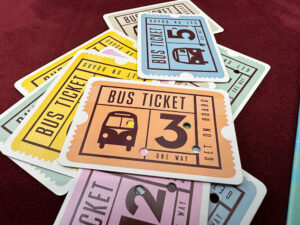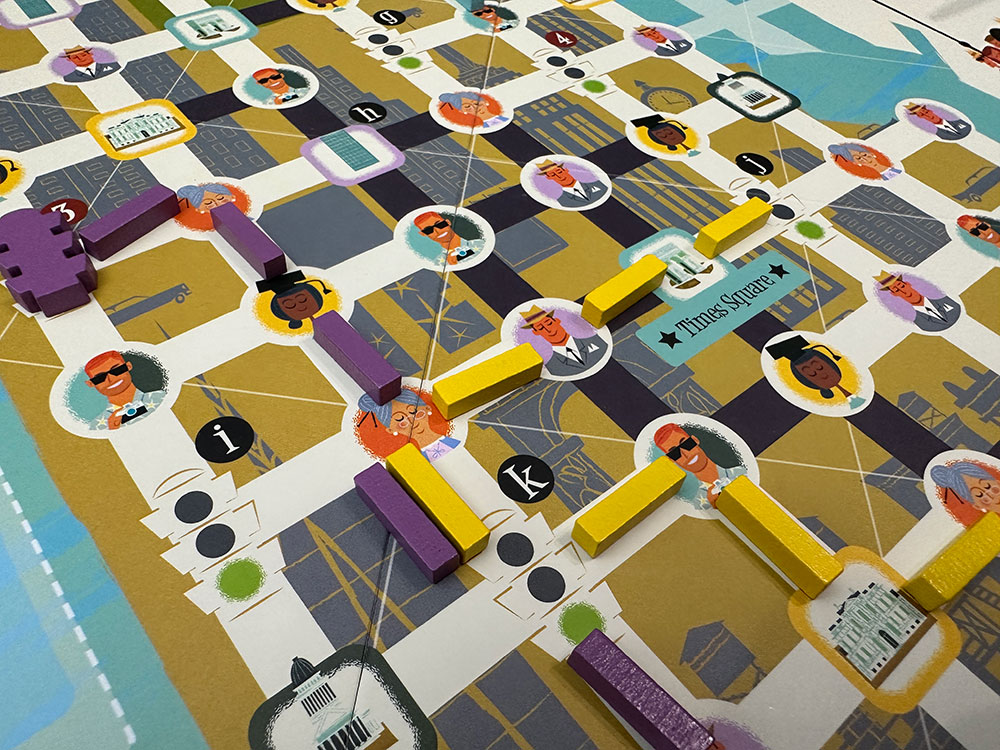 As far as big name board game designers go, Saashi may not be the most recognized around the world, but fans of his interesting and often quirky games are among the most avid I’ve encountered. Most of Saashi’s games were published in Japan under the Saashi & Saashi label. And that was where I first encountered Let’s Make a Bus Route—an interesting take on flip-and-write mechanism that had players writing on a communal dry erase board.
As far as big name board game designers go, Saashi may not be the most recognized around the world, but fans of his interesting and often quirky games are among the most avid I’ve encountered. Most of Saashi’s games were published in Japan under the Saashi & Saashi label. And that was where I first encountered Let’s Make a Bus Route—an interesting take on flip-and-write mechanism that had players writing on a communal dry erase board.
Get On Board is essentially the same game with a new coat of paint and some wooden sticks replacing the messy dry-erase madness. So let’s discuss how it plays and see if this IELLO-published version is worth checking out.
Gameplay Overview:
During setup, you’ll choose to play on the New York or London side of the map, depending on player count. Each player will get a starting location and a score sheet. Then you’ll flip up bus tickets from a deck of 12 cards that correspond to certain types of routes you can place on the central board.

Each player will have a different route shape they can place for each bus ticket, so while bus ticket #4 may be two straight lines for me, it correspond to three lines with two turns for my opponent. You must start your line from your starting space and you can never double back or branch off, only extending your single bus route. Along the way you’ll pick up and drop off passengers at each intersection, all of which score differently.
The nice elderly ladies just like riding the bus it seems, so you’ll get an increasing number of points the more of them you pick up. Students need to get to school, obviously, so you’ll score points equal to the number of students you pick up multiplied by the number of schools you visit. Tourists load onto the bus, but all leave as soon as you get to the next interesting site. You’ll score points based on how many tourists you had and then have to start loading them up again. And businessmen work very similarly to tourists, but instead of exploring the city they just need to get dropped off at the office.

You do have a few other things to look out for. While you can never double back on your own route you can build your route where other players have already gone. This will cause traffic to back up and earn you an increasing number of negative points the more often you fill the city with congestion. Also if the bus ticket for the round didn’t give you the turn you desperately needed, you can change a straight into a turn (up to 5 times per game, losing an increasing number of points every time you choose to do it).

There are a few other bonus points for hitting some of the best sightseeing spots around town, meeting common objectives, and hitting a personal goal of reaching a few specific sections of the board. You’ll tally up points after the 12th card is revealed, and whoever has earned the most points, of course, wins.
Game Experience:
One of the key things I look for when I’m playing a game is always whether I feel like there are multiple interesting ways to try to win. In a lot of “point-salady” games, the answer is yes, but I also crave interaction in my games that can be lacking in those kinds of games. I don’t need “take that” direct attacks, but I want enough interaction to care about what other people at the table are trying to do. As much as I love roll-and-writes that is often sorely lacking.

Get on Board excels on both of these dimensions. You can win by grabbing all the elderly folks, or by getting all the students and get them to school, or by turning your bus route into a sightseeing tour. All of these options, if done successfully, can score enough points to win the game. But you’ll have to fight your way through the traffic of other players’ buses and sometimes have to make hard choices about when to give up on Plan A if too many folks are in your way.
That said, there isn’t a huge amount of decision space here. Most turns often amount to… do I turn left, or right, or take a penalty to just keep going straight? You don’t do a lot on any given turn and therefore there aren’t really many options. But the whole experience is quick and can often be played in about 20 minutes. As a filler-length game, it does what it sets out to do and doesn’t outstay it’s welcome.
Finally—don’t let the “New York & London” subtitle fool you. The board here is two sided but it’s really just a function of player count. There aren’t any other differences between what they offer. A bit of a let down if you are expecting to flip it over and find something new and interestingly thematic to distinguish the two city maps.
Final Thoughts:
If you like flip-and-writes, you’ll almost for sure like Get on Board. If you don’t like flip-and-writes because there is often no interaction between players, you’ll still might like Get on Board. It’s quick to play and offers a lot of different strategies. Most turns will only offer a couple of small choices but over the course of a quick 20-minute game, they add up to be a fulfilling experience.
This also might be the start of your Saashi fandom. Soon you’ll be tracking down obscure Japanese card games from the past decade with the rest of us.
Final Score: 4 Stars – A fun flip-and-write that has a solid amount of player interaction.
 Hits:
Hits:
• Quick but fulfilling flip-and-write experience.
• Lots of different ways to score points.
• Common map allows for a lot more player interaction for this style of game.
Misses:
• Decision space can feel limiting.
• Board looks pretty busy as route markers stack up.





















